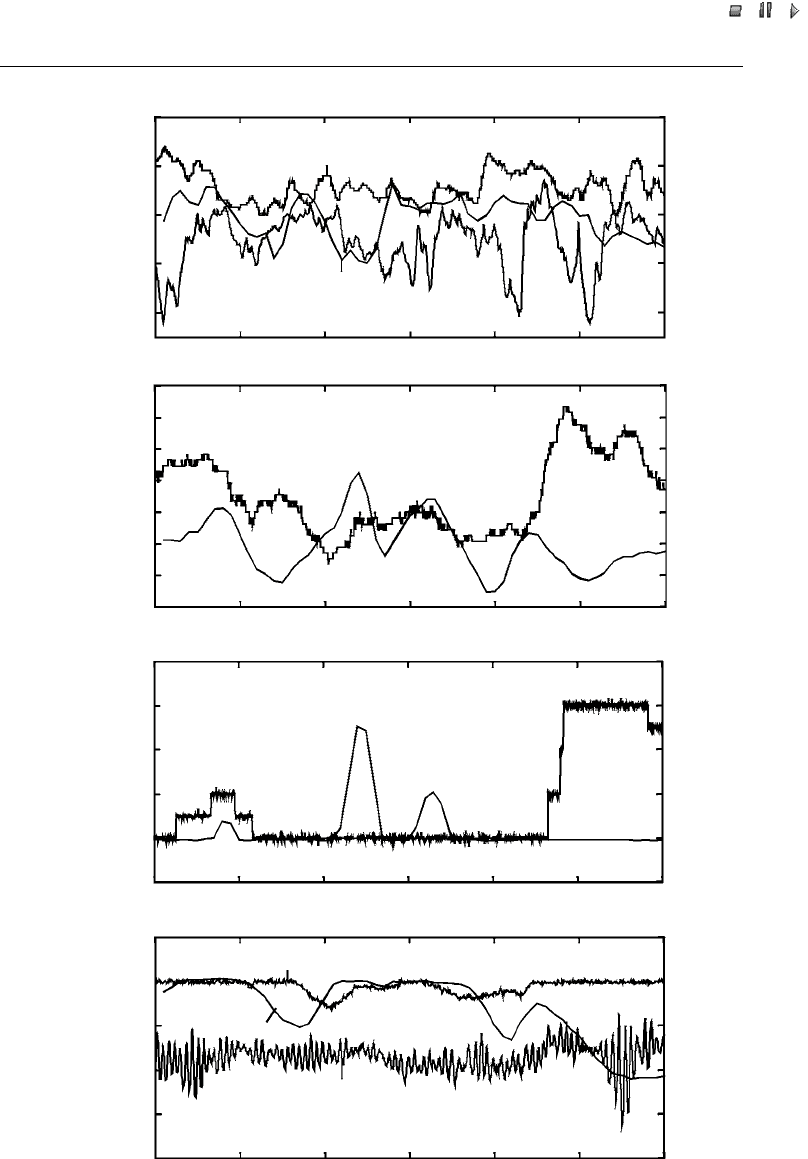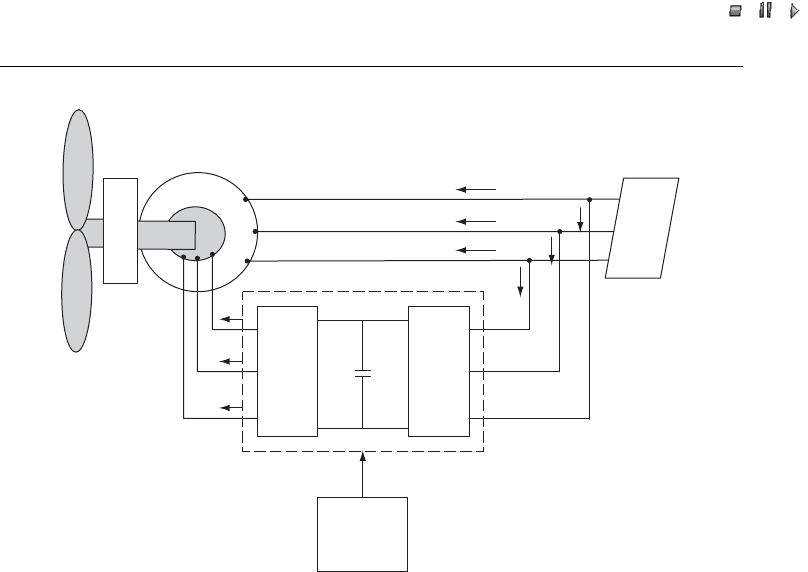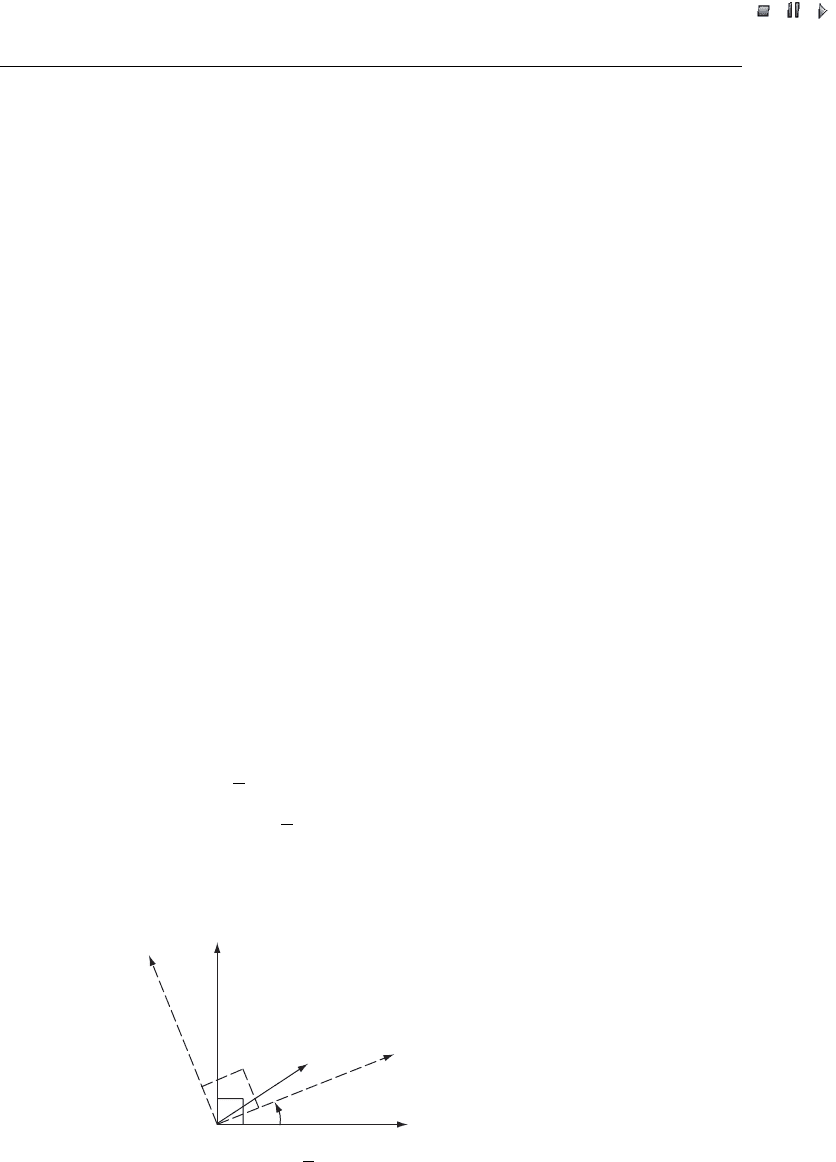AckermannTh. (ed) Wind Power in Power Systems
Подождите немного. Документ загружается.


//INTEGRAS/KCG/P AGIN ATION/ WILEY /WPS /FINALS_1 4-12- 04/0470855088_ 26_CHA25 .3D – 581 – [555–586/32]
17.12.2004 10:50PM
16
14
12
10
8
01020
30
40
50 60
Direct drive
Direct drive
Direct drive
Direct drive
Doubly fed
Doubly fed
Doubly fed
Doubly fed
Constant speed
Constant speed
Time (s)
Time (s)
(a)
(b)
(c)
(d)
1.08
1.06
1.04
1.02
1.00
0.98
0.96
0.94
0102030405060
Time (s)
0 102030405060
Time (s)
0102030405060
Wind speed (m/s)Rotor speed (p.u.)
–2
0
2
4
6
8
Pitch angle (deg)Output power (p.u.)
1.2
1.0
0.8
0.6
0.4
0.2
Figure 25.14 Measurement results: (a) measured wind speed sequence; (b) simulated rotor speed;
(c) simulated pitch angle; and (d) simulated output power. Note: See Figure 25.13
Wind Power in Power Systems 581

//INTEGRAS/KCG/P AGIN ATION/ WILEY /WPS /FINALS_1 4-12- 04/0470855088_ 26_CHA25 .3D – 582 – [555–586/32]
17.12.2004 10:50PM
fed induction generator and of a variable-speed wind turbine with a direct-drive
synchronous generator are depicted. Figure 25.14(d) shows the measured output power
of all three turbine types. The rotor speed of the constant speed wind turbine was not
measured because the small rotor speed variations are difficult to measure. This quan-
tity is therefore not included in the graph.
The characteristics of the wind turbine are given in Table 25.5. Table 25.3 includes the
generator parameters of the induction generator used in the constant-speed wind turbine
and the variable-speed wind turbi ne with a doubly fed inducti on generator, and Table
25.4 provides the parameters of the direct-drive synchronous generator.
25.8.2 Comparison of measurements and simulations
For two reasons, the available measurements cannot be used for a direct, quantitative
validation of the models. First, the wind speed is measured with a single anemometer,
whereas the rotor has a large surface. Second, the measured wind speed is severely disturbed
by the rotor wake, because the anemometer is located on the nacelle. Therefore, the wind
speed that is measured with a single anemometer is not an adequate measure for the
wind speed acting on the rotor as a whole. It is thus not possible to feed a measured wind
speed sequence into the model in order to compare measured with simulated response.
The discrepancy between the wind speed measured with a single anemometer and the
aggregated wind speed acting on the rotor is clearly illustrated by the behaviour of
the variable-speed wind turbine with a doubly fed induction generator after about 25 s
as observed in Figure 25.14. The wind speed decreases from about 12 to 10 m/s at that
time. However, rotor speed, pitch angle and generated power increase. From the fact
that the observed be haviour is physically impossible, it can be concluded that the wind
speed measured by the anemometer is not a good indicator of the wind speed acting on
the rotor as a whole.
Table 25.5 Simulated wind turbine parameters
Turbine characteristic Value
Rotor speed (rpm)
a
17
Minimum rotor speed (rpm)
b
9
Nominal rotor speed (rpm)
b
18
Rotor diameter (m) 75
Area swept by rotor, A
r
(m
2
) 4418
Nominal power (MW) 2
Nominal wind speed (m/s)
a
15
Nominal wind speed (m/s)
b
14
Gearbox ratio
a
1:89
Gearbox ratio
b
1:100
Inertia constant, H
wr
(s) 2.5
Shaft stiffness, K
s
(p.u./el. rad)
a
0.3
a
For a constant-speed wind turbine.
b
For a variable-speed wind turbine.
582 Reduced-order Modelling of Wind Turbines

//INTEGRAS/KCG/P AGIN ATION/ WILEY /WPS /FINALS_1 4-12- 04/0470855088_ 26_CHA25 .3D – 583 – [555–586/32]
17.12.2004 10:50PM
Thus, although it would be possible to use the wind speed sequence measured by the
anemometer as the model’s input, it can not be used for a quantitative comparison of
the measured with the simulated response to the wind speed sequence for validating the
model. Therefore, we carry out only a qualitative comparison, which leads to the
following conclusions.
The simulation results dep icted in Figure 25.13 show the following.
.
In particular, short-term output power fluctuations (i.e. in the range of seconds) are
more severe in the case of constant-speed wind turbines than in the case of the two
variable-speed wind turbine types [Figure 25.13(d)]. The reason is that in the variable-
speed wind turbines the rotor functions as an energy buffer.
.
The response of the variable-speed wind turbine types is similar. This is because
their behaviour is, to a large extent, determined by the controllers, which are identical.
These findings also apply to the measurements depicted in Figure 25.14.
A comparison of the simulated and measured responses shows that:
.
The range of the measured and simulated rotor speed fluctuations of the variable-
speed turbines are similar (they fluctuate over a bandwidth of about 0.1 p.u.); see
Figures 25.13(b) and 25.14(b).
.
Measured and simulated pitch angle behaviour are similar with respect to the rate of
change (approximately 3
to 5
per second) and the minimum (approximately 0
) and
maximum value (approximately 6
); see Figures 25.13(c) and 25.14(c).
.
The range of the measured and simulat ed output power fluctuations of constant-
speed wind turbines (Typ e A) and that of wind turbines with doubly fed induction
generators (Type C) are similar (they fluctuate over a bandwidth of approximately
0.3 to 0.4 p.u.); see Figures 25.13(d) and 25.14(d).
.
The rate of change of the measured output power fluctuations of the constant-speed
wind turbine [Type A; see Figure 25.14(d)] differs from that of the simulated output
power fluctuations [see Figure 25.13(d)] . However, the correlation between the meas-
ured wind speed and output power is rather weak for these wind turbines. The
observed discrepancies between measurements and simulation are therefore probably
caused by inaccuracies in the measurements rather than by the model.
.
The range of the measured output power fluctuations of wind turbines with direct-
drive synchronous generators (Type D – approximately 0.2 p.u. [see Figure 25.14(d)] –
differs from that of the simulated output power fluctuations – approximately 0.4 p.u.
[see Figure 25.13(d)]. This is probably caused by the fact that in the measurements, the
direct-drive wind turbine is exposed only to rather high wind speeds, whereas in the
simulation there are also lower wind speeds.
Although a quantitative validation of the models is not possible with the available
measurements, this qua litative comparison of measured and simulated responses gives
confidence in the accuracy and usability of the derived models. It shows that the
assumptions and simplifications applied in modelling the rotor, the generator and the
controllers have rather limited consequences, and it can be assumed that they do not
Wind Power in Power Systems 583

//INTEGRAS/KCG/P AGIN ATION/ WILEY /WPS /FINALS_1 4-12- 04/0470855088_ 26_CHA25 .3D – 584 – [555–586/32]
17.12.2004 10:50PM
affect the simulation results to a larger extent than do other sources of uncertainty, such
as the system load and the committed generators.
25.9 Conclusions
This chapter presented models of the three most important current wind turbine types. The
models match the simplifications applied in PSDSs and include all subsystems that
determine the grid interaction. Therefore, they are suitable for analysing the impact of
large-scale connection of wind power on the dynamic behaviour of electrical power systems.
The response of the models to a measured wind speed sequence was investigated, and
the measurements show an acceptable degree of correspondence. This gives confidence
in the derived models and shows that the results of the applied simplifications are
acceptable.
References
[1] Akhmatov, V. (2002) ‘Variable-speed Wind Turbines with Doubly-fed Induction Generators, Part I:
Modelling in Dynamic Simulation Tools’, Wind Engineering 26(2) 85–108.
[2] Akhmatov, V., Knudsen, H., Nielsen, A. H. (2000) ‘Advanced Simulation of Windmills in the Electric
Power Supply’, International Journal of Electrical Power & Energy Systems 22(6) 421–434.
[3] Anderson, P. M., Bose, A. (1983) ‘Stability Simulation of Wind Turbine Systems’, IEEE Transactions on
Power Apparatus and Systems 102(12) 3791–3795.
[4] Anderson, P. M., Agrawal, B. L., Van Ness J. E. (1990) Subsynchronous Resonance in Power Systems,
IEEE Press, New York.
[5] Bossanyi, A. A. (2000) ‘The Design of Closed Loop Controllers for Wind Turbines’, Wind Energy 3(3)
149–163.
[6] Chen, Z., Spooner, E. (2001) ‘Grid Power Quality with Variable Speed Wind Turbines’, IEEE Transac-
tions on Energy Conversion 16(2) 148–154.
[7] Fujimitsu, M., Komatsu, T., Koyanagi, K., Hu, K., Yokoyama. R. (2000) ‘Modeling of Doubly-fed
Adjustable-speed Machine for Analytical Studies on Long-term Dynamics of Power System’, in Proceed-
ings of PowerCon, Perth, pp.25–30.
[8] Grainger, J. J., Stevenson Jr, W. D. (1994) Power System Analysis, McGraw-Hill, New York.
[9] Hatziargyriou, N. (Ed.) (2001) Modeling New Forms of Generation and Storage, Cigre
´
Task Force
38.01.10, Paris.
[10] Heier, S. (1998) Grid Integration of Wind Energy Conversion Systems, John Wiley & Sons Ltd, Chicester, UK.
[11] Hinrichsen, E. N., Nolan, P. J. (1982) ‘Dynamics and Stability of Wind Turbine Generators’, IEEE
Transactions on Power Apparatus and Systems 101(8) 2640–2648.
[12] Kru
¨
ger, T., Andresen, B. (2001) ‘Vestas OptiSpeed – Advanced Control Strategy for Variable Speed Wind
Turbines’, in Proceedings of the European Wind Energy Conference, Copenhagen, Denmark, pp. 983–986.
[13] Kundur, P. (1994) Power System Stability and Control, McGraw-Hill, New York.
[14] Panofsky, H. A., Dutton, J. A. (1984) Atmospheric Turbulence: Models and Methods for Engineering
Applications, John Wiley & Sons Inc., New York.
[15] Papathanassiou, S. A., Papadopoulos, M. P. (1999) ‘Dynamic Behavior of Variable Speed Wind Turbines
under Stochastic Wind’, IEEE Transactions on Energy Conversion 14(4) 1617–1623.
[16] Patel, M. R. (2000) Wind and Solar Power Systems, CRC Press, Boca Raton, FL.
[17] Pedersen, J. K., Akke, M., Poulsen, N. K., Pedersen, K. O. H. (2000) ‘Analysis of Wind Farm Islanding
Experiment’, IEEE Transactions on Energy Conversion 15(1) 110–115.
[18] Petru, T., Thiringer, T. (2000) ‘Active Flicker Reduction from a Sea-based 2.5 MW Wind Park Connected
to a Weak Grid’, presented at the Nordic Workshop on Power and Industrial Electronics (NORpie
´
/2000),
Aalborg, Denmark.
584 Reduced-order Modelling of Wind Turbines

//INTEGRAS/KCG/P AGIN ATION/ WILEY /WPS /FINALS_1 4-12- 04/0470855088_ 26_CHA25 .3D – 585 – [555–586/32]
17.12.2004 10:50PM
[19] Shinozuka, M., Jan, C.-M. (1972) ‘Digital Simulation of Random Processes and its Applications’, Journal
of Sound and Vibration 25(1) 111–128.
[20] Simiu, E., Scanlan, R. H. (1986) Wind Effects on Structures: An Introduction to Wind Engineering, 2nd
edn, John Wiley & Sons Inc., New York.
[21] Slootweg J. G., Polinder H., Kling, W. L. (2001) ‘Initialization of Wind Turbine Models in Power System
Dynamics Simulations’, in Proceedings of 2001 IEEE Porto Power Tech Conference, Porto.
[22] SPTI (Shaw Power Technologies Inc.) (1997) Online documentation of PSS/E
TM
(Power System Simu-
lator for Engineers) 25, USPT, Schenectady, NY.
[23] Wasynczuk, O., Man, D. T., Sullivan, J. P. (1981) ‘Dynamic Behavior of a Class of Wind Turbine
Generators during Random Wind Fluctuations’, IEEE Transactions on Power Apparatus and Systems
100(6) 2837–2845.
Wind Power in Power Systems 585

//INTEGRAS/KCG/P AGIN ATION/ WILEY /WPS /FINALS_1 4-12- 04/0470855088_ 26_CHA25 .3D – 586 – [555–586/32]
17.12.2004 10:50PM

//INTEGRAS/KCG/P AGIN ATION/ WILEY /WPS /FINALS_1 4-12- 04/0470855088_ 27_CHA26 .3D – 587 – [587–602/16]
17.12.2004 10:50PM
26
High-order Models of
Doubly-fed Induction Generators
Eva Centeno Lo
´
pez and Jonas Persson
26.1 Introduction
This chapter focuses on the modelling of doubly-fed induction generators (DFIGs),
typically used in Type C wind turbines as defined in Section 4.2.3. This generator model
is currently (2005) one of the most researched wind generator models and there is
growing interest in understanding its behaviour. The term ‘doubly fed’ indicates that
the machine is connected to the surrounding power system at two points; directly via the
stator side, and also via the rotor side through a voltage source converter (VSC).
We start the chapter by presenting a model of a DFIG at the most detailed level,
namely a 6th-order state-variable model including both rotor and stator electromagne tic
transients. In this way, the model covers fast transient phenomena and becomes an
appropriate model for studies on instantaneous value modelling of the power system.
When simulating a DFIG with a reduced-order model, fast transients are neglected in
the simulation. A reduced-order model can be used in transient studies that assume that
all quantities vary with fundamental frequency and that neglect grid transients. This
assumption may be appropriate, depending on which types of phenomena the model
should be valid for.
As mentioned above, the 6th-order DFIG model is developed in detail in this ch apter.
The VSC of the rotor is not modelled with a detailed modulation scheme, though. It is
assumed that the switchi ng frequency is infinite. In spite of this simplification, we take
into account the limitations in the voltage generation that the converter imposes due to
the DC link. These limitations will be implemented as limitations to the voltage and
torque controllers. The VSC is outlined in this chapter.
Wind Power in Power Systems Edited by T. Ackermann
Ó 2005 John Wiley & Sons, Ltd ISBN: 0-470-85508-8 (HB)

//INTEGRAS/KCG/P AGIN ATION/ WILEY /WPS /FINALS_1 4-12- 04/0470855088_ 27_CHA26 .3D – 588 – [587–602/16]
17.12.2004 10:50PM
We will describe a sequencer that includes different modes of operation of a DFIG.
The need for such a sequencer arises from the fact that whenever there is a fault in the
interconnected power system, the system of the DFIG must be able to handle the
resulting high current s without causing any damage to the equipment.
This chapter will cover neither aerodynamic modelling of wind turbines nor gearbox
representation, since these were described in Chapter 24. The DFIG model does not
include any magnetic saturation, air-gap harmonics or skin effects either.
The described DFIG model has been implemented as a user model in the power system
simulation software Simpow
1
developed by STRI (see Centeno, 2000; Fankhauser et al.,
1990). Simpow contains both possibilities to simulate electromagnetic transients
and electromechanical transient s, however, in this chapter we will simulate in electro-
magnetic transients mode.
26.2 Advantages of Using a Doubly-fed Induction Generator
When using conventional squirrel cage asynchronous machines (i.e. Type A wind
turbines), very high magnetising currents are drawn from the power grid when recover-
ing from a nearby fault in the power system. If the power system is weak and cannot
provide a sufficient magnetising current in the postfault transient state, the squirrel cage
asynchronous machine keeps on accelerating. The asynchronous machine draws as
much magnetising current as possible from the grid, and a severe voltage drop takes
place. The voltage drop will stop only once the protection system disconnects the wind
turbine from the grid. A rapid power reduction can be used to deal with this problem
(for an explanation and a demonstration, see Sections 24.4.5.1 and 29.3, respectively).
An alternative is to use an asynchronous generator with its rotor connected to a VSC
via slip rings , a so-called doubly fed induction generator (DFIG; i.e. a Type C wind
turbine). In this concept, the VSC is connected to a control system that determines the
voltage that the VSC impresses onto the rotor of the induction generator. This concept
also provides variable-speed capability, which makes it possible to optimise power
production, as explained in Section 24.3.1. By controlling the rotor voltage, the VSC
control can control the current that is drawn from the grid. The voltage that the VSC
impresses onto the rotor is determined by speed, torque and voltage. These are the
controllers of which the VSC control consists.
26.3 The Components of a Doubly-fed Induction Generator
The DFIG consists of the components depicted in Figure 26.1, which shows the two
connections of the machine to the surrounding network that give rise to the term
‘doubly fed’. The VSC consis ts of two converters with a DC link between them. The
VSC connects the rotor to the network, which is labelled ‘Grid’ in Figure 26.1.
The components of the DFIG are:
.
wind turbine;
.
gearbox;
.
induction generator;
.
converters (VSC);
588 High-order Models of Doubly-fed Induction Generators

//INTEGRAS/KCG/P AGIN ATION/ WILEY /WPS /FINALS_1 4-12- 04/0470855088_ 27_CHA26 .3D – 589 – [587–602/16]
17.12.2004 10:50PM
.
DC link (VSC);
.
voltage control;
.
speed control;
.
torque control.
The aim of the VSC shown in Figure 26.1 is to provide the rotor voltage. The VSC control
determines the rotor voltage and uses speed, torque and voltage controllers for this purpose.
Regarding the above list, we will assume here that the wind turbine provides a
constant mechanical torque T
MECH
to the generator, and we will neglect the gearbox.
Chapter 24 describes the modelling of the wind turbine. The wind representation (gusts,
turbulence an d random variations) is discussed briefly in Sections 24.6.2.4 and 24.6.2.5
and is descri bed in more detail in Section 25.5.2. The wind turbine representation, and
consequently also the wind representation, are neglected in this chapter.
We will derive the equations of the induction generator. The converters and the DC
link will not be modelled in detail, though. Instead, the VSC is represented by its output –
the rotor voltage – and this is modelled as the output of the VSC control.
26.4 Machine Equations
In this section, the basic equations of the machine are presented (for the equations of
induction generator, VSC and sequencer, see also Centeno, 2000). Before we actually
VSC
control
VSC
Induction
generator
DC link
i
rNc
i
sa
i
sb
i
sc
i
rc
i
rb
i
ra
i
rNa
i
rNb
Grid
Gear
box
Figure 26.1 Doubly fed induction generator. Note: VSC ¼voltage source converter; i ¼current;
subscript r indicates a rotor quantity; subscript s indicates stator quantity; subscripts a, b and c
indicate phase a, b and c winding axes; subscript N indicates the grid side
Wind Power in Power Systems 589

//INTEGRAS/KCG/P AGIN ATION/ WILEY /WPS /FINALS_1 4-12- 04/0470855088_ 27_CHA26 .3D – 590 – [587–602/16]
17.12.2004 10:50PM
describe these equations, we will present the vector method, which is used to represent
time-dependent magnitudes, and also the reference frame that will be used throughout
this chapter.
26.4.1 The vector method
The vector method is a simple but mathematically precise method for handling the
transient performance of electrical machines (A
¨
ngquist, 1984). By using the vector
method the number of equations required to describe the machine’s behaviour is
decreased. This is a function of the fact that the reactances of the machine are constant
in time when repres enting the machine in its reference frame. Furthermore, if stator and
rotor vector quantities are expressed in the same reference frame, time-varying coeffi-
cients in the differential equations are avoided. This is because of the flux linkages
between stator and rotor and simplifies the solution to such a system of diff erential
equations. For the later target (i.e. to refer stator and rotor equations to the same
reference frame), the so-called Park’s transformation is used.
We assume balanced voltages and nonground connection points, which means we
have zero sequence free quantities. That reduces the degree of freedom to two, and it is
therefore possible to work in a two-dimen sional plane. Two orthogonal axes are
defined, the d and q axis. The d axis is called the direct axis and lies collinear to the
rotor phase a winding. The q axis is called the quadrature axis and lies perpendicular to
and leading the d axis. We will work in a rotor-fixed reference frame and therefore the
equations for the rotor do not have to be transformed. However, the stator equations
have to be transform ed. There are two reasons for choosing the rotor coordinate system.
First, this applies to much lower frequen cies and thus the resolution of the differential
equation system will be simpler. The second reason is that the rotor circuit is connected
to a VSC and its control equipment, which means that the converter needs variables in
the rotor coordinate system as input. The reference frames are illustrated in Figure 26.2,
including the space vector,
S(t), given by:
SðtÞ¼S
d
ðtÞþjS
q
ðtÞ: ð26:1Þ
where subscripts d and q indicate the direct and quadrature axis components of the
space vector, respectively, and j ¼
ffiffiffiffiffiffiffi
1
p
.
q
d
S(t )
Rotor reference frame, r
Stator reference frame,
s
θ
g
–
Figure 26.2 Reference frames. Note: S(t) ¼ space vector; d ¼direct axis; q ¼quadrature axis;
g
¼ the angle between the two reference frames
590 High-order Models of Doubly-fed Induction Generators
